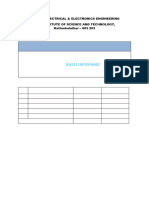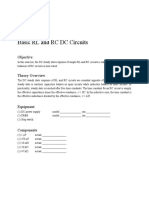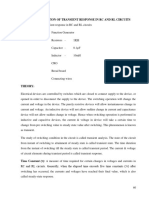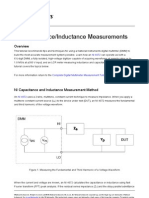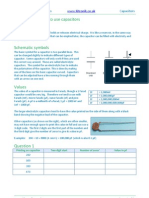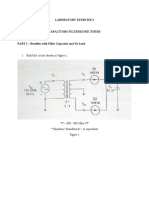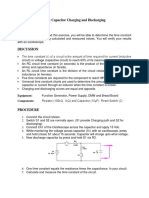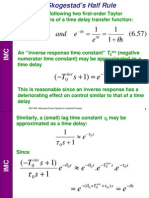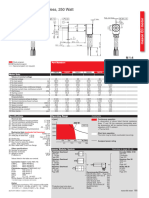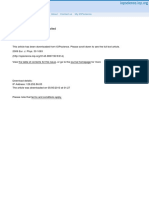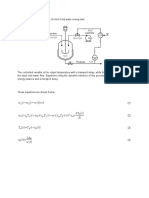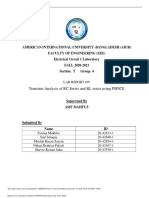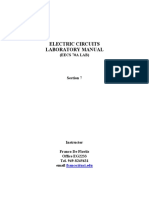Lab 01-Transient Response of A Series RC Circuit
Lab 01-Transient Response of A Series RC Circuit
Uploaded by
Aly HuzmurCopyright:
Available Formats
Lab 01-Transient Response of A Series RC Circuit
Lab 01-Transient Response of A Series RC Circuit
Uploaded by
Aly HuzmurOriginal Description:
Original Title
Copyright
Available Formats
Share this document
Did you find this document useful?
Is this content inappropriate?
Copyright:
Available Formats
Lab 01-Transient Response of A Series RC Circuit
Lab 01-Transient Response of A Series RC Circuit
Uploaded by
Aly HuzmurCopyright:
Available Formats
Department of Electrical Engineering
Electrical Network Analysis Lab Manual
Lab 01-Transient Response of a series RC Circuit
Name
Roll Number
Faculty Member
Dated
Lab Engineer 1
Lab Engineer 2
Semester
Section
Marks Obtained
Department of Electrical Engineering
Electrical Network Analysis Lab Manual
Introduction
In this lab students will be transient response of a resistive capacitive circuit..
Objective
Observe the transient response of a resistive capacitive circuit.
Equipment
1.
2.
3.
4.
1.
Function Generator
DMM
Oscilloscope and Probes
Capacitor: 10 nF
Resistor: 1 k, 2.2 k, 3.3 k, 5.6k, 8.2 k
Conduct of Lab
1. Students are required to perform this experiment individually.
2. In case the lab experiment is not understood, the students are advised to seek help
from the course instructor, lab engineers, assigned teaching assistants (TA) and lab
attendants.
Theory and Background
Capacitors find many applications, both general and specific, in electronic circuits. In this
experiment, we will discover the basic behavior of a capacitor as an energy storage device in
a DC circuit.
Because a capacitor is formed of an insulating medium known as a dielectric, direct
current cannot flow between the electrodes. Consequently, the series RC circuit for DC
source reveals an open circuit ( resistance). In large-valued capacitors, it may take a visibly
short time for the reading to stabilize as the device charges. With small-valued capacitors,
however, the effect is almost instantaneous. Some electrolytic capacitors have imperfect
dielectrics and will conduct a small amount of current referred to as leakage. This shows up
as a high resistance in the circuit.
To demonstrate the transient response that occurs when a capacitor is connected to a
DC source, we will use an oscilloscope. The square wave signal allows us to charge and
discharge the capacitor.
Charging of Capacitor
Where is the final value of voltage at t = to
Discharging of Capacitor
Where is the initial value of voltage at t = to
4
Department of Electrical Engineering
Electrical Network Analysis Lab Manual
Time Constant (): It is a measure of time required for certain changes in voltages and
currents in RC and RL circuits. When the elapsed time exceeds five time constants (5) after
switching has occurred, the currents and voltages have reached their final value, which is
also called steady-state response. The time constant of an RC circuit is the equivalent
capacitance multiplied by the Thvenin resistance as seen from the terminals of the
equivalent capacitor.
= RC
Figure 1
Lab Tasks
1. Determine the value of capacitor from its marking. Record this in Table-1. Some
capacitors use a code like the resistor color code, using numbers instead of colors;
the value is usually in pF; e.g., 102 would indicate 10 x 10 pF = 1000pF. Other
capacitors simply have the literal value on them; e.g., 0.1. Also, measure the actual
value of the capacitor using LCR meter and record it in Table 1.
2. Measure the actual values of resistances using DMM and record them in Table-2.
3. Using the measured value of each resistor in Table-2, calculate the expected time
constant.
4. Connect the circuit in Figure 1.
5. Give a square wave signal of 1Vp from the function generator.
6. Set the frequency in a way that you can measure the time constant conveniently on
the oscilloscope. The period T of the square wave must be long enough to allow the
complete charge/discharge of the capacitor. Usually T=10 is appropriate for this
purpose.
7. For each value of R in Table-2, observe and measure the time constant.
8. Calculate capacitance of the capacitor from the measured time constant values using
formula:
Capacitance (Calculated) = Time Constant (measured) / R (measured)
Department of Electrical Engineering
Electrical Network Analysis Lab Manual
TABLE-1
CAPACITOR VALUE
Nominal
Measured
TABLE-2
Resistance
(Nominal)
1 k
2.2 k
3.3 k
5.6 k
8.2 k
Resistance
(Measured)
Time constant
(Calculated)
Time constant
(Measured)
Capacitance
(Calculated)
You might also like
- Unit - Ii - 28.08.2021Document63 pagesUnit - Ii - 28.08.2021G.L. Jai Purushotham RajNo ratings yet
- Elab3 Jan 09Document13 pagesElab3 Jan 09Marlon BoucaudNo ratings yet
- Tushar Tanishq (Experiment 3)Document12 pagesTushar Tanishq (Experiment 3)lefeyok304No ratings yet
- Alternating Current CircuitsDocument8 pagesAlternating Current CircuitsShafiq HafizullahNo ratings yet
- Lab 02-Transient Response of A Series RL CircuitDocument4 pagesLab 02-Transient Response of A Series RL CircuitRobert SimbergNo ratings yet
- Lab 5 - Time Constant of RC CircuitsDocument4 pagesLab 5 - Time Constant of RC CircuitshamzaNo ratings yet
- Experiment #1 - Ece191 - Navata, Genilla, Ubana, AlcantaraDocument7 pagesExperiment #1 - Ece191 - Navata, Genilla, Ubana, AlcantaraGabriel S. UbañaNo ratings yet
- RC Circuits - George Ricarrson 2501987261Document9 pagesRC Circuits - George Ricarrson 2501987261George RYNo ratings yet
- NA Exp6-RL RC CircuitDocument8 pagesNA Exp6-RL RC CircuitakshithadharmasothNo ratings yet
- Muhammad Raihan Sunaryo - RC Circuits - 12 Apr 2023Document8 pagesMuhammad Raihan Sunaryo - RC Circuits - 12 Apr 2023MuhammadRaihan sunaryoNo ratings yet
- Experiment Guide For RC Circuits 1. CapacitorsDocument9 pagesExperiment Guide For RC Circuits 1. CapacitorsShafiqul Islam ShafiqNo ratings yet
- RC RL RLC 3.0 PDFDocument13 pagesRC RL RLC 3.0 PDFlp_blackoutNo ratings yet
- Experiment Physic RC CircuitDocument7 pagesExperiment Physic RC CircuitLia XeraNo ratings yet
- BEE Experiment (3,4,5,6)Document25 pagesBEE Experiment (3,4,5,6)xikigo1934No ratings yet
- Experiment # 2: ObjectiveDocument12 pagesExperiment # 2: ObjectiveAizaz Khan ZäziíììNo ratings yet
- RC Circuits: J H U, P ADocument6 pagesRC Circuits: J H U, P APavan PatelNo ratings yet
- Hardware 04Document9 pagesHardware 04Ahmed TristanNo ratings yet
- Lab 06 RC, RL, and RLC Transients-2Document11 pagesLab 06 RC, RL, and RLC Transients-2Ece KayaNo ratings yet
- LabReport 3 FinaleDocument16 pagesLabReport 3 FinaleChiara CalvoNo ratings yet
- Experiment 1 (BSC) PME PY 304Document6 pagesExperiment 1 (BSC) PME PY 304khananuNo ratings yet
- RC Circuit and Its ApplicationTerm PaperDocument13 pagesRC Circuit and Its ApplicationTerm PapersummitzNo ratings yet
- The RC Circuit: TheoryDocument4 pagesThe RC Circuit: TheoryCanh LuongtienNo ratings yet
- The RC Circuit: Pre-Lab QuestionsDocument8 pagesThe RC Circuit: Pre-Lab QuestionsMd. Sazidul Haque SazzadNo ratings yet
- Experiment 3 REVISED 1Document12 pagesExperiment 3 REVISED 1ohanci123No ratings yet
- Transient Response of RC CircuitDocument5 pagesTransient Response of RC CircuitJayesh Ruikar100% (1)
- Lab 1 Basic RL and RC DC Circuits PDFDocument32 pagesLab 1 Basic RL and RC DC Circuits PDFMarc CalilungNo ratings yet
- AC Electrical Circuits Lab Manual 123Document98 pagesAC Electrical Circuits Lab Manual 123xyzzyzNo ratings yet
- Chapter 4: Electrical TransientsDocument6 pagesChapter 4: Electrical TransientsSandra Wendam100% (1)
- Lab Assignment #2 Due: Oct. 5, 20 Materials Needed: Sep. 30, 20 Fall 2020Document5 pagesLab Assignment #2 Due: Oct. 5, 20 Materials Needed: Sep. 30, 20 Fall 2020api-482290211No ratings yet
- The Study of DC Transients in RC CircuitDocument2 pagesThe Study of DC Transients in RC CircuitNur Muhammad Alif RamliNo ratings yet
- CC TEC RC FiltersDocument14 pagesCC TEC RC FiltersGuYue LiNo ratings yet
- RC Timers and Timing CircuitsDocument9 pagesRC Timers and Timing CircuitsManuj GuptaNo ratings yet
- Keitebetse 331 Lab1Document21 pagesKeitebetse 331 Lab1Rre KeitebetseNo ratings yet
- Astable Multivibrator: Non Linear Applications:-A) Astable Multivibrator B) Mono Stable MultivibratorDocument15 pagesAstable Multivibrator: Non Linear Applications:-A) Astable Multivibrator B) Mono Stable MultivibratorFarhan AkhterNo ratings yet
- 3.transient Analysis of Series RL, RC CircuitsDocument11 pages3.transient Analysis of Series RL, RC CircuitsshubhamNo ratings yet
- Physics PraticalDocument4 pagesPhysics PraticalRohit MishraNo ratings yet
- Capacitor and Inductor Transient Response: ECE 270 Lab #4 Capacitors and InductorsDocument14 pagesCapacitor and Inductor Transient Response: ECE 270 Lab #4 Capacitors and InductorsAlex DixonNo ratings yet
- Exp 5Document8 pagesExp 5Kurl Vincent GamboaNo ratings yet
- 06 C Measurement 2Document15 pages06 C Measurement 2Awais MohammedNo ratings yet
- How To Use CapacitorsDocument3 pagesHow To Use CapacitorsGeoff Hampson100% (1)
- 241 RLC Circuit Ac SourceDocument14 pages241 RLC Circuit Ac SourceWsma AmswNo ratings yet
- Eelab Exp8Document12 pagesEelab Exp8Leona Arreza Huerte100% (1)
- ENA - Lab - Manual (Update 17-4-2019) PDFDocument76 pagesENA - Lab - Manual (Update 17-4-2019) PDFMuhammad SaadNo ratings yet
- Laboratory Manual For Ac Electrical CircuitsDocument90 pagesLaboratory Manual For Ac Electrical CircuitsLharie Mae BecinaNo ratings yet
- RC PDFDocument5 pagesRC PDFRaghad TabounNo ratings yet
- Laboratory Exercise 3Document7 pagesLaboratory Exercise 3BenedictNo ratings yet
- 9 Capacitor Charging and DischargingDocument2 pages9 Capacitor Charging and DischargingMuhammad UsmanNo ratings yet
- Analysis of An RC Phase Shifter Circuit:: ObjectiveDocument7 pagesAnalysis of An RC Phase Shifter Circuit:: Objectiveayesha amjadNo ratings yet
- Course OutlineDocument28 pagesCourse OutlineIdrisa Mussa ChubwaNo ratings yet
- SRM Institute of Science and TechnologyDocument8 pagesSRM Institute of Science and TechnologyRaskshanna100% (1)
- Lab 7Document8 pagesLab 7Magdalena SimicNo ratings yet
- Eee Lab Report 07Document11 pagesEee Lab Report 07Sayeed MohammedNo ratings yet
- Exp. No. - 3 Step Response of RLC CircuitDocument9 pagesExp. No. - 3 Step Response of RLC CircuitEsh-war RajNo ratings yet
- Switched Capacitor Circuitry: Reveal AnswerDocument16 pagesSwitched Capacitor Circuitry: Reveal AnswerShorav SuriyalNo ratings yet
- ELEN 214 Lab Manual 7-1Document7 pagesELEN 214 Lab Manual 7-1Ratnesh ChaturvediNo ratings yet
- ENA ManualDocument60 pagesENA ManualAbdul Munim100% (1)
- Laboratory Manual For Ac Electrical CircuitsDocument80 pagesLaboratory Manual For Ac Electrical CircuitsAngelo Palaming100% (1)
- STEM: Science, Technology, Engineering and Maths Principles Teachers Pack V10From EverandSTEM: Science, Technology, Engineering and Maths Principles Teachers Pack V10No ratings yet
- 1-An Atomic Description of Dielectrics: Page 587 CollegeDocument25 pages1-An Atomic Description of Dielectrics: Page 587 CollegeAbdulrhman fNo ratings yet
- LEKX5320Document373 pagesLEKX5320Cristian RiosNo ratings yet
- Skogested Half RuleDocument8 pagesSkogested Half RuleBen Lim50% (2)
- 1939 Cole CurtisDocument22 pages1939 Cole CurtisPooja ParisharNo ratings yet
- Inertia Constant EstimationDocument8 pagesInertia Constant EstimationSubhadeep PaladhiNo ratings yet
- Comparison of Gas-Turbine and Combined Cycle Models For System Stability StudiesDocument7 pagesComparison of Gas-Turbine and Combined Cycle Models For System Stability Studiesjmant100% (1)
- Maxon Ec45 136210Document1 pageMaxon Ec45 136210compimagmaticNo ratings yet
- Newton'S Law of Cooling Revisited: Home Search Collections Journals About Contact Us My IopscienceDocument23 pagesNewton'S Law of Cooling Revisited: Home Search Collections Journals About Contact Us My IopscienceAngelo Omar Apolo ChambaNo ratings yet
- Lecture Note 02 PDFDocument104 pagesLecture Note 02 PDFHilario TomeNo ratings yet
- Lab 5Document21 pagesLab 5Sindbad HooNo ratings yet
- Time Domain Analysis of Control SystemDocument49 pagesTime Domain Analysis of Control Systemanasmos danielNo ratings yet
- Fundamentals of A Motor Thermal Model and Its Applications in Motor ProtectionDocument15 pagesFundamentals of A Motor Thermal Model and Its Applications in Motor Protectionnokdiego100% (1)
- Summary of Relay Setting CalculationDocument3 pagesSummary of Relay Setting Calculationkspm007No ratings yet
- A New Mathematical Model and Control of A Three-Phase Ac-Dc Voltage Source ConverterDocument9 pagesA New Mathematical Model and Control of A Three-Phase Ac-Dc Voltage Source ConverterrasoolNo ratings yet
- Modelo Térmico LabDocument2 pagesModelo Térmico LabJhonny PerezNo ratings yet
- Parameter List NC - PMC (FO-3015 160il)Document55 pagesParameter List NC - PMC (FO-3015 160il)anon_243370520No ratings yet
- The Transfer FunctionDocument16 pagesThe Transfer FunctionSyuhadah Noordin100% (1)
- Engineering: Systems The Glass IndustryDocument13 pagesEngineering: Systems The Glass IndustryAmer AlkalaifhNo ratings yet
- American International University-Bangladesh (Aiub) Faculty of Engineering (Eee) Electrical Circuit 1 Laboratory FALL 2020-2021 Section: T Group: 4Document7 pagesAmerican International University-Bangladesh (Aiub) Faculty of Engineering (Eee) Electrical Circuit 1 Laboratory FALL 2020-2021 Section: T Group: 4Shahabuddin SarkerNo ratings yet
- Problems: Section 8.3: The Response of A First Order Circuit To A Constant Input P8.3-1Document14 pagesProblems: Section 8.3: The Response of A First Order Circuit To A Constant Input P8.3-1Thiago BastosNo ratings yet
- Lecture Notes 1 PDCDocument172 pagesLecture Notes 1 PDCJanuNo ratings yet
- Motor Thermal ModelDocument15 pagesMotor Thermal ModelnagarajasarmaNo ratings yet
- Modeling and Identification of An Electric MotorDocument17 pagesModeling and Identification of An Electric MotorAlda EnglandNo ratings yet
- Start Inhibit FunctionDocument11 pagesStart Inhibit Functionlimkokchiang809No ratings yet
- Maxon A Max Catalog Data2 PDFDocument28 pagesMaxon A Max Catalog Data2 PDFM. Luthfi Alhadi ZNo ratings yet
- Solved ProblemsDocument8 pagesSolved Problemsali.alhayki2002No ratings yet
- Concentration Changes in A CSTR (Continuous Stirred Tank Reactor)Document10 pagesConcentration Changes in A CSTR (Continuous Stirred Tank Reactor)pekanselandar0% (1)
- Electric Circuits Laboratory Manual: (Eecs 70A Lab)Document6 pagesElectric Circuits Laboratory Manual: (Eecs 70A Lab)Ali Walid AbuamounehNo ratings yet
- The Source-Free RC Circuit: V (T) Across TheDocument58 pagesThe Source-Free RC Circuit: V (T) Across Thesriyalakshmi005No ratings yet


